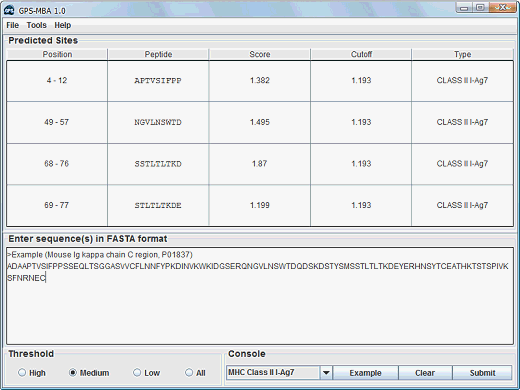※ GPS-MBA INTRODUCTION:
Type 1 diabetes (Diabetes mellitus type 1, T1D or T1DM) is a severe chronic autoimmune disorder and relapsing-remitting disease that is characterized by the insidious loss of self-tolerance and progressive destruction of insulin-producing pancreatic β-cells in the islets of Langerhans, with the presence of overt hyperglycemia at clinical diagnosis (Bluestone et al., 2010; Fierabracci, 2011; Lehuen et al., 2010; Luo et al., 2010; Panagiotopoulos et al., 2004; Sherr et al., 2008; von Herrath et al., 2007; Waldron-Lynch and Herold, 2011). The incidence and prevalence of T1D is dramatically increasing worldwide during the past decades, while the onset and development of T1D is controlled by both genetic and environmental factors (Bluestone et al., 2010; Fierabracci, 2011; Luo et al., 2010; Panagiotopoulos et al., 2004; Sherr et al., 2008; Waldron-Lynch and Herold, 2011). Accumulative analysis revealed that a variety of immune cell types including CD4+, CD8+ T cells, macrophages and dendritic cells (DCs) are involved in β-cell death, and CD4+ T cells play a predominant role in T1D pathology (Fierabracci, 2011; Lehuen et al., 2010; Luo et al., 2010). Thus, the development of immunoregulatory therapeutic approaches has been an urgent demand for preventing or curing the T1D (Bluestone et al., 2010; Fierabracci, 2011; Lehuen et al., 2010; Luo et al., 2010; Panagiotopoulos et al., 2004; Sherr et al., 2008; von Herrath et al., 2007; Waldron-Lynch and Herold, 2011).
Besides immunosuppressive drugs and antibody-based immunotherapies, antigen-based "tolerogenic" immunotherapy has attracted great attention as the third-generation approach for its highly selective targeting of aberrant T cells (Bluestone et al., 2010; Fierabracci, 2011; Lehuen et al., 2010; Luo et al., 2010; Panagiotopoulos et al., 2004; Sherr et al., 2008; Waldron-Lynch and Herold, 2011). It was demonstrated that the MHC class II haplotype, I-Ag7, is strongly linked to susceptibility to T1D in the non-obese diabetic (NOD) mouse (Harrison et al., 1997; Reizis et al., 1997; Suri et al., 2005). Similar linkage to the human HLA-DQ8 molecule, I-Ag7 is expressed by DCs to present β-cell epitopes from some well-defined autoantigens including insulin, glutamic acid decarboxylase (GAD) and insulinoma antigen 2 (IA-2) (Bluestone et al., 2010; Fierabracci, 2011; Luo et al., 2010; Panagiotopoulos et al., 2004; Sherr et al., 2008; Waldron-Lynch and Herold, 2011). These epitopes are usually composed of 10 to 30 amino acids with the 9-amino acids core sequences for I-Ag7/HLA-DQ8 and T-cell receptor (TCR) binding (Harrison et al., 1997; Reizis et al., 1997; Suri et al., 2005). In this regard, identification of I-Ag7/HLA-DQ8 epitopes is fundamental for understanding the molecular mechanisms of T1D and further designing immunotherapeutic peptides. In 2009, the first-in-man Phase I clinical study was reported that proinsulin peptide injection is both well tolerated and safe (Thrower et al., 2009). Recently, a C-peptide deduced from the GAD 65 isoform has generated promising results in Phase II trials, although three Phase III trials are still underway (Fierabracci, 2011; Luo et al., 2010; Waldron-Lynch and Herold, 2011).
In this work, we developed a novel GPS-MBA software package for the prediction of I-Ag7 and HLA-DQ8. The experimentally identified epitopes were collected from the scientific literature, while a modified Gibbs sampling approach was adopted to determine core nonamers in these epitopes. For training and prediction, a refined GPS algorithm was used. By extensive evaluations and comparisons, the prediction performance of GPS-MBA determined to be promising and much better than other tools. The leave-one-out validation result for I-Ag7 is accuracy (Ac) of 94.96%, sensitivity (Sn) of 71.70%, and specificity (Sp) of 95.05%, while for HLA-DQ8 is 95.29% (Ac), 64.93% (Ac) and 95.38% (Sp). All experimentally identified T1D antigens together with their epitopes were taken into the TEDB 1.0. Taken together, the prediction and analysis results are helpful for further experimental consideration, and the GPS-MBA can serve as a useful program for experimentalists. The online service and local packages of GPS-MBA 1.0 were implemented in JAVA and could be freely accessed for academic research at: http://mba.biocuckoo.org.
GPS-MBA 1.0 User Interface

For publication of results please cite the following article:  GPS-MBA: Computational analysis of MHC Class II Epitopes in Type 1 Diabetes
GPS-MBA: Computational analysis of MHC Class II Epitopes in Type 1 DiabetesRuikun Cai, Zexian Liu, Jian Ren, Chuang Ma, Tianshun Gao, Yanhong Zhou, Qing Yang and Yu Xue. PLoS ONE, 2012, 7(3): e33884. |



